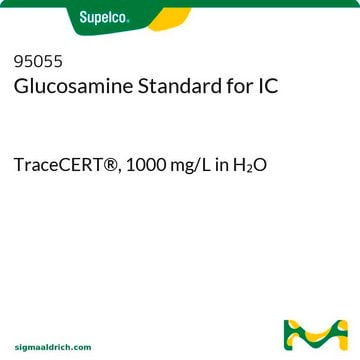G5509
D-Glucosamine 6-phosphate
≥98% (TLC)
Synonim(y):
2-Amino-2-deoxyglucose 6-phosphate
About This Item
Polecane produkty
pochodzenie biologiczne
natural (inorganic)
Próba
≥98% (TLC)
Postać
powder
metody
thin layer chromatography (TLC): suitable
zanieczyszczenia
≤10% water (Karl Fischer)
kolor
white
rozpuszczalność
water: 50 mg/mL, clear to hazy, colorless to almost colorless
temp. przechowywania
−20°C
ciąg SMILES
NC(C=O)C(O)C(O)C(O)COP(O)(O)=O
InChI
1S/C6H14NO8P/c7-3(1-8)5(10)6(11)4(9)2-15-16(12,13)14/h1,3-6,9-11H,2,7H2,(H2,12,13,14)
Klucz InChI
AEJSSXDYDSUOOZ-UHFFFAOYSA-N
Powiązane kategorie
Opis ogólny
Powiązanie
Inne uwagi
Kod klasy składowania
11 - Combustible Solids
Klasa zagrożenia wodnego (WGK)
WGK 3
Temperatura zapłonu (°F)
Not applicable
Temperatura zapłonu (°C)
Not applicable
Środki ochrony indywidualnej
Eyeshields, Gloves, type N95 (US)
Certyfikaty analizy (CoA)
Poszukaj Certyfikaty analizy (CoA), wpisując numer partii/serii produktów. Numery serii i partii można znaleźć na etykiecie produktu po słowach „seria” lub „partia”.
Masz już ten produkt?
Dokumenty związane z niedawno zakupionymi produktami zostały zamieszczone w Bibliotece dokumentów.
Klienci oglądali również te produkty
Nasz zespół naukowców ma doświadczenie we wszystkich obszarach badań, w tym w naukach przyrodniczych, materiałoznawstwie, syntezie chemicznej, chromatografii, analityce i wielu innych dziedzinach.
Skontaktuj się z zespołem ds. pomocy technicznej










